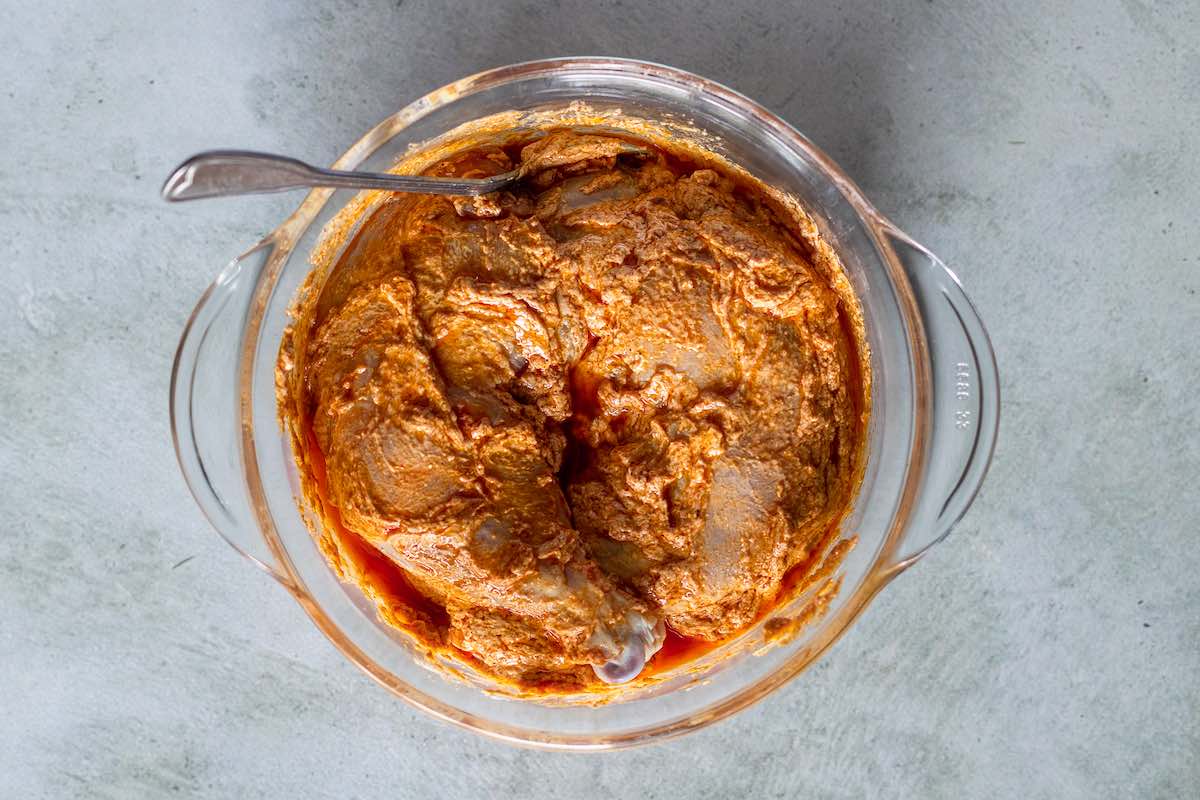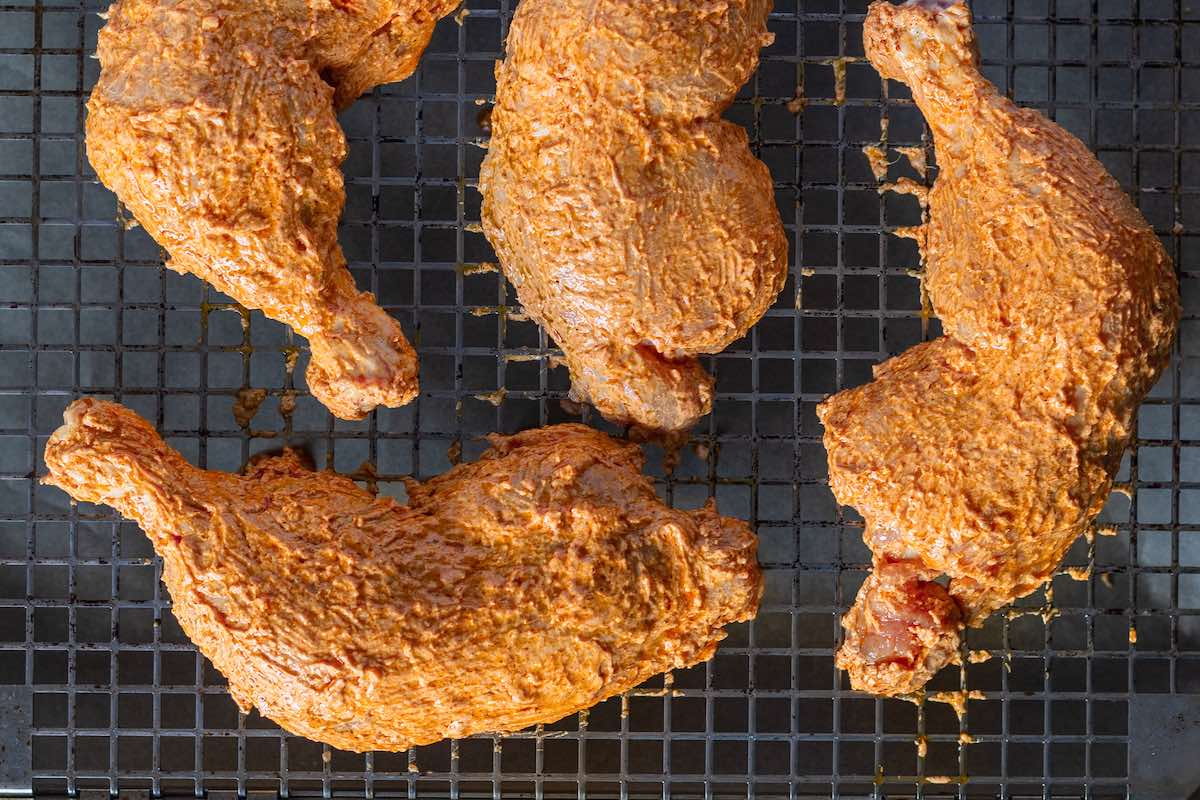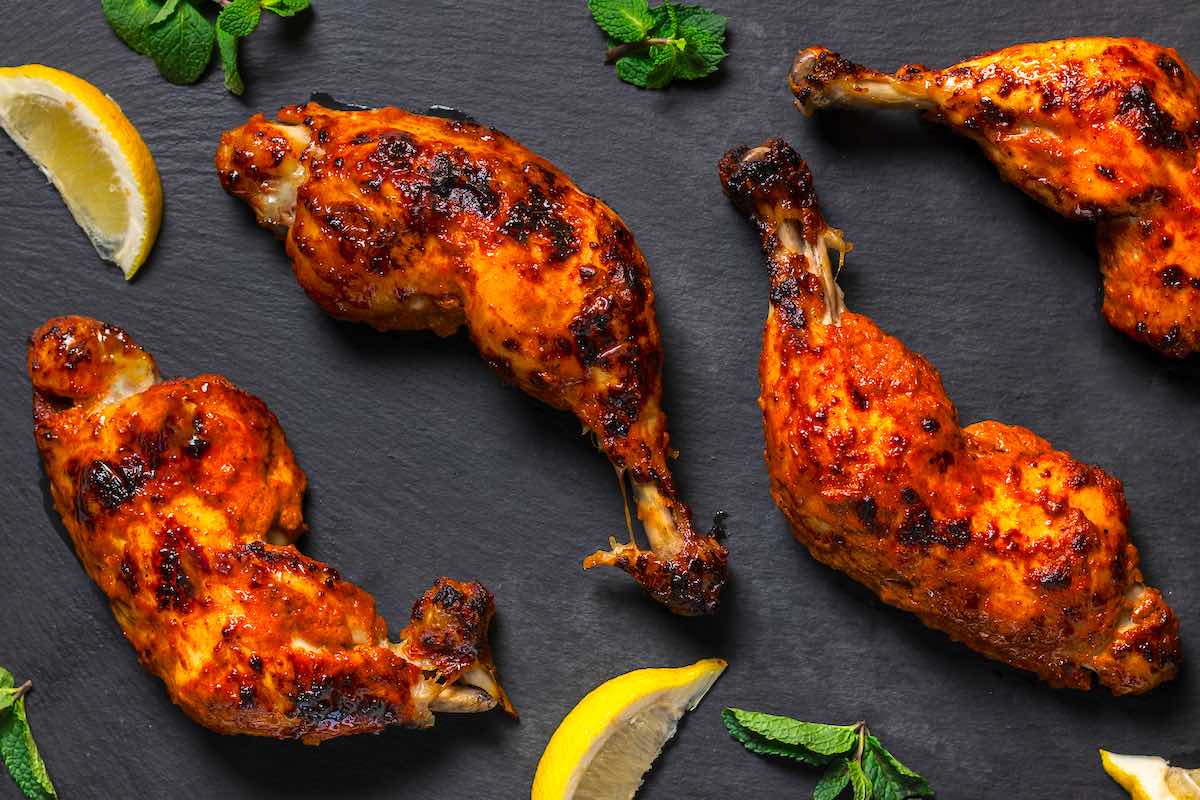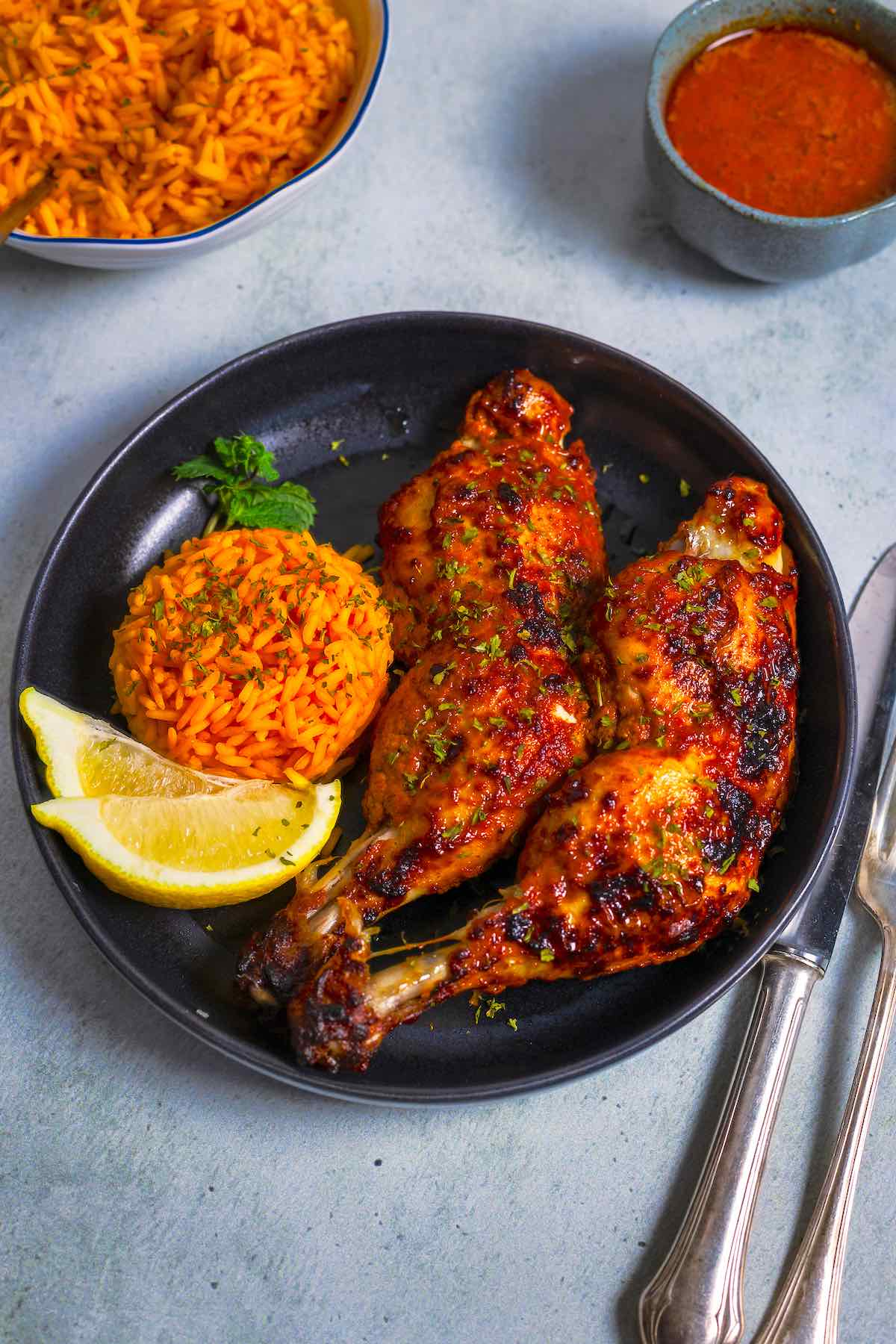Have you ever stared at an Indian restaurant menu wondering if you should take the plunge and order tandoori chicken? I’ve been there too! The vibrant red color might make you curious (or maybe a little nervous), but trust me, once you understand what tandoori chicken tastes like, you’ll be ordering it again and again
As someone who’s enjoyed tandoori chicken countless times, I’m excited to break down this iconic dish’s flavor profile for you. Let’s dive into the delicious world of tandoori chicken!
The Flavor Profile of Tandoori Chicken Explained
Tandoori chicken offers a complex symphony of flavors that dance on your tongue. If I had to sum it up in a few words, I’d describe tandoori chicken as:
- Smoky and charred from the high-heat cooking method
- Tangy and tender from the yogurt marinade
- Earthy and aromatic from the blend of Indian spices
- Moderately spicy with a pleasant warmth (not overwhelming heat)
- Juicy and succulent on the inside with a slightly crispy exterior
The beauty of tandoori chicken is how these distinct flavor elements come together to create something truly magical The tanginess from the yogurt balances perfectly with the earthy spices, while the smokiness adds depth that makes this dish irresistible.
The Key Taste Elements That Make Tandoori Chicken Special
The Yogurt Marinade: Tangy Tenderness
One of the most distinctive elements in tandoori chicken’s taste is the yogurt marinade Plain Greek yogurt or natural yogurt (never the flavored stuff!) creates a slight tanginess while also working to tenderize the meat
The yogurt does double-duty here – it breaks down proteins in the chicken making it incredibly tender, while also forming that distinctive tangy backdrop that makes tandoori chicken so recognizable.
The Spice Blend: Warmth and Complexity
When you take your first bite of tandoori chicken, you’ll notice a wave of warm, earthy spices. The typical spices include:
- Garam masala (a must-have for authentic flavor)
- Cumin (adds earthiness)
- Turmeric (provides color and subtle flavor)
- Coriander (offers citrusy notes)
- Cinnamon (gives a hint of sweetness)
- Paprika or Kashmiri chili (for color and mild heat)
- Cayenne pepper (for those who want more heat)
These spices don’t make the chicken overwhelmingly hot (unless you want it that way!). Instead, they create a complex warmth that’s incredibly satisfying. The spices penetrate deep into the meat during marination, ensuring flavor in every bite.
The Smokiness: Char and Depth
Traditional tandoori chicken gets its distinctive smoky flavor from being cooked in a tandoor – a clay oven that reaches extremely high temperatures. The meat develops a beautiful char that adds incredible depth to the overall taste.
Even if you’re eating tandoori chicken that’s been made in a conventional oven or grill (like most restaurants outside India do), good chefs will ensure that smoky element is present. Sometimes they’ll add a touch of smoked paprika to the marinade to replicate that authentic tandoor-cooked flavor.
The Ginger-Garlic Punch
Fresh ginger and garlic are crucial components that give tandoori chicken its aromatic punch. These ingredients add a spicy, fragrant quality that’s unmistakable and absolutely essential to the authentic taste experience.
What To Expect From Your First Bite
When you take your first bite of properly prepared tandoori chicken, here’s the experience you can expect:
- First impression: A slightly crisp, charred exterior with a beautiful red-orange color
- Initial flavor: The warm spices hit your palate along with a hint of tanginess
- Middle notes: The smoky char becomes more apparent, mixing with the earthy spices
- Texture: Incredibly juicy and tender meat that practically falls off the bone
- Finish: A lingering warmth from the spices with a pleasant, not overwhelming heat
The overall effect is mouth-watering and deeply satisfying. It’s no wonder tandoori chicken has become one of the most popular Indian dishes worldwide!
Is Tandoori Chicken Spicy?
This is a question I get asked all the time! The answer is: it depends. Traditional tandoori chicken has a moderate level of spiciness – warming rather than burning. It’s certainly not bland, but it’s also not going to have you reaching desperately for water.
The beautiful thing about tandoori chicken is that the spice level can be adjusted. In restaurants, you can usually request your preferred spice level. If you’re making it at home, you can simply adjust the amount of chili powder or cayenne pepper in the marinade.
The heat in tandoori chicken is balanced by the cooling effect of the yogurt marinade, creating a harmonious taste experience rather than an overwhelming one.
The Texture: Just as Important as the Taste
We can’t talk about what tandoori chicken tastes like without discussing its texture, which is a crucial part of the overall experience:
- The exterior: Slightly charred and crisp from the high-heat cooking
- The interior: Incredibly moist and tender thanks to the yogurt marinade
- The meat: Typically bone-in pieces that remain juicy throughout cooking
The contrast between the slightly crisp exterior and the succulent interior is one of tandoori chicken’s most distinctive and delightful characteristics.
Traditional Accompaniments That Enhance the Flavor
Tandoori chicken is often served with specific accompaniments that complement and enhance its flavor:
- Mint chutney: The cooling, herbaceous quality balances the warm spices
- Sliced onions: Adds sharpness and crunch
- Lemon wedges: A squeeze of fresh lemon brightens all the flavors
- Naan bread: Perfect for scooping up every last bit of flavor
- Raita: A cooling yogurt sauce that complements the spiced chicken
These sides aren’t just an afterthought – they’re carefully chosen to create a complete flavor experience that highlights the best qualities of tandoori chicken.
A Brief History: Understanding Tandoori Chicken’s Origins
Tandoori chicken might seem like an ancient dish, but it’s actually a relatively modern creation in the long history of Indian cuisine. The dish originated in Peshawar (now in Pakistan) in the 1930s when a chef experimented with cooking chicken in a tandoor oven, which had previously been used mainly for baking bread.
The experiment was hugely successful, and tandoori chicken quickly spread throughout the Indian subcontinent. By the 1970s and 1980s, it had gained international fame, becoming one of the most recognizable Indian dishes worldwide.
Understanding this history helps appreciate why tandoori chicken tastes the way it does – it was designed to showcase the unique cooking properties of the tandoor oven, which gives the chicken its distinctive smoky flavor and juicy texture.
How to Make Authentic Tandoori Chicken at Home
If my description has got your mouth watering, you might want to try making tandoori chicken at home! Here’s a simplified approach:
- Prepare the marinade: Mix yogurt with minced ginger, garlic, and spices (garam masala, cumin, coriander, turmeric, paprika, and a pinch of cayenne)
- Marinate the chicken: Coat chicken pieces (preferably bone-in) thoroughly and refrigerate for at least 4 hours (overnight is better!)
- Bring to room temperature: Take the chicken out of the fridge about 30 minutes before cooking
- Cook at high heat: Bake on a wire rack in a very hot oven (450°F/230°C) or grill until charred and cooked through
- Rest before serving: Let the chicken rest for a few minutes to redistribute juices
Without a tandoor, you won’t get the exact same taste, but you can come surprisingly close by using smoked paprika in your marinade and cooking at the highest heat your home oven can manage.
Nutritional Benefits: Tandoori Chicken Is Actually Pretty Healthy!
I love that tandoori chicken isn’t just delicious – it’s also relatively healthy compared to many other popular dishes. Here’s why:
- It’s typically made with skinless chicken, reducing fat content
- The yogurt marinade adds protein and calcium
- Many of the spices have anti-inflammatory properties
- It’s grilled rather than fried, making it lower in calories
- The high protein content makes it satisfying without needing heavy sides
Of course, restaurant versions might add more oil or salt than homemade versions, but overall, tandoori chicken can be part of a balanced, nutritious diet.
Final Thoughts: Is Tandoori Chicken Worth Trying?
Whether you’re new to Indian cuisine or a seasoned fan, tandoori chicken offers a accessible yet authentic taste experience that’s hard to beat. Next time you’re at an Indian restaurant or feeling adventurous in the kitchen, remember this description and take the plunge – your taste buds will thank you!
So what are you waiting for? Go out and experience the magnificent taste of tandoori chicken for yourself. I promise you won’t regret it!

Authentic tandoori chicken recipe that tastes like it’s from a restaurant
Tandoori chicken is, in my opinion, the most popular and tasty Indian dish ever. It features chicken marinated in yogurt and spices. Traditionally, the chicken is then cooked in a tandoor, which is a clay oven. In my version, I oven-bake it, and it honestly tastes like something from a restaurant!
- Chicken. I prefer using chicken leg quarters for this recipe because they are fatty, flavorful, and have the bone intact. You can also use a mix of chicken legs and drumsticks. If you want boneless chicken, opt for chicken thighs.
- Yogurt. Plain Greek yogurt or natural yogurt. Please do not use flavored yogurt.
- Lemon juice. Optional, but if your yogurt is NOT on the tard side, add 1 teaspoon of lemon or lime juice.
- Ginger and garlic. Freshly minced. Fresh ginger and garlic give the chicken Asian notes and add great flavor. Use fewer or more garlic cloves, depending on your preferences.
- Spices. The spice blend I prefer using for my tandoori chicken recipe consists of garam masala, cumin, cinnamon, ground coriander, turmeric, and smoked paprika. While you can customize the spice blend for tandoori chicken, I recommend you never skip the garam masala, as it gives the dish an authentic Indian feel.
- Olive oil. For the marinade. You can use butter or ghee, but I find it firms up a little too much for my liking.
- Salt. To taste.
How to make tandoori chicken
I’ve included step-by-step photos below to make this recipe easy to follow at home. For the full printable recipe instructions and ingredient quantities, scroll to the recipe card at the bottom of this post.

Step 1- Prepare the marinade. Add the yogurt to a mixing bowl. Add the spices, freshly minced ginger and garlic, and olive oil.

Step 2- Marinate. Pat dry the chicken pieces and put them in the marinade. Mix well to get the chicken completely coated. Let the chicken sit for at least 10 minutes.

Step 3- Assemble. Remove the chicken from the yogurt mixture and shake off the excess marinade. Place the chicken on the wire rack.

Step 4- Bake for 25 to 30 minutes or until the chicken is nicely charred and cooked through.
- Use even-sized chicken pieces to ensure even cooking. If you are using different cuts of chicken, I recommend cooking them in batches.
- Don’t overcrowd the baking rack so the chicken pieces brown well on all sides.
- Check the internal temperature. Remove the chicken from the oven as soon as it reads 165F in the thickest part of the chicken.
- Resting the chicken is essential because it allows the juices to redistribute and yield the juiciest meat ever.
Tandoori chicken is juicy thanks to the yogurt marinade and earthy due to the Indian spices, ginger, and garlic. Cooked over high heat, the chicken is also naturally smoky. This is why I like to add smoked paprika to the marinade to make up for the smokiness that the traditional cooking method provides.

Indian Tandoori Chicken vs South African Tandoori Chicken
FAQ
What is the taste of tandoori chicken?
Tandoori tastes spicy and flavorful, with a slightly smoky taste due to the high heat of the tandoor.
How would you describe tandoori chicken?
Tandoori chicken is a popular Indian dish of chicken marinated in yogurt and spices, giving it a vibrant red or orange color, before being cooked in a tandoor (a cylindrical clay oven). The result is tender, smoky, and flavorful chicken with a slightly charred exterior. Key ingredients include yogurt, ginger, garlic, garam masala, and various chilies and spices like turmeric or Kashmiri red chili powder.
Which is better, chicken tikka or tandoori?
The main difference is that Tandoori Chicken is a whole or large cut of chicken, often bone-in, cooked directly in a tandoor oven, while Chicken Tikka consists of smaller, boneless pieces of chicken, also marinated in yogurt and spices and cooked in a tandoor or over a grill. Tandoori chicken is essentially the base preparation, with chicken tikka being its smaller, boneless counterpart that is often served in a creamy sauce (like in Chicken Tikka Masala).
Is a tandoori sweet or spicy?
Tandoori Chicken is filled with aromatic flavors like spicy, smoky, and savory when cooked in the clay oven with green chilies. It’s then roasted to reach the right amount of softness.
